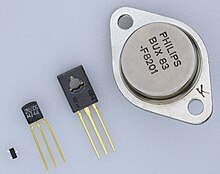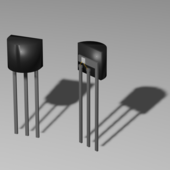
Back ترانزستور ثنائي القطب Arabic Біпалярны транзістар Byelorussian Біпалярны транзыстар BE-X-OLD Биполярен транзистор Bulgarian Transistor bipolar Catalan Bipolární tranzistor Czech Bipolar transistor Danish Bipolartransistor German Διπολικό τρανζίστορ Greek Transistor de unión bipolar Spanish
 | |
| Working principle | Semiconductor |
|---|---|
| Invention year | December 1947 |
| Pin names | Collector, base, emitter |
| Electronic symbol | |
  BJTs PNP and NPN schematic symbols | |

A bipolar junction transistor (BJT) is a type of transistor that uses both electrons and electron holes as charge carriers. In contrast, a unipolar transistor, such as a field-effect transistor (FET), uses only one kind of charge carrier. A bipolar transistor allows a small current injected at one of its terminals to control a much larger current between the remaining two terminals, making the device capable of amplification or switching.
BJTs use two p–n junctions between two semiconductor types, n-type and p-type, which are regions in a single crystal of material. The junctions can be made in several different ways, such as changing the doping of the semiconductor material as it is grown, by depositing metal pellets to form alloy junctions, or by such methods as diffusion of n-type and p-type doping substances into the crystal. The superior predictability and performance of junction transistors quickly displaced the original point-contact transistor. Diffused transistors, along with other components, are elements of integrated circuits for analog and digital functions. Hundreds of bipolar junction transistors can be made in one circuit at a very low cost.
Bipolar transistor integrated circuits were the main active devices of a generation of mainframe and minicomputers, but most computer systems now use Complementary metal–oxide–semiconductor (CMOS) integrated circuits relying on the field-effect transistor (FET). Bipolar transistors are still used for amplification of signals, switching, and in mixed-signal integrated circuits using BiCMOS. Specialized types are used for high voltage switches, for radio-frequency (RF) amplifiers, or for switching high currents.